
Apple Vision Pro pre-orders are just a week away. Now the company is serving up some details about how the ordering process including the use of face scans for a proper fit.
Apple Vision Pro pre-orders are set to begin on January 19th with a release date on February 2nd.
Face ID Scans During Vision Pro Ordering
In a recent marketing email, Apple explains “when you order Apple Vision Pro, you’ll need to scan your face with an iPhone or iPad with Face ID. This helps us determine the right size Light Seal and head bands, which work together to give you a precise fit.”
So not only does Vision Pro come with two different headbands, there’s also more than one size for those headbands, as well as the ‘Light Seal’ lens shroud. We don’t know exactly how many different sizes there are, but if I recall correctly from my hands-on time with the headset, Apple had shown small, medium, and large versions of the ‘Solo Knit Band’. As for the other headband, the ‘Dual Loop’, it isn’t clear if there’s multiple sizes since that strap has two adjustments already.
Vision Pro also supports vision correction inserts. Customers can give Apple their prescription at the time of purchase to order a pair of inserts that matches their vision prescription so the headset can be used without glasses (for an additional cost of $150). Non-prescription ‘reader’ inserts can also be ordered for $100.
Buy Vision Pro Without an iPhone or iPad
Apple says that you’ll need an iPhone or iPad with Face ID to buy Vision Pro online, but those without one can buy the headset in an Apple Store. Ostensibly the company will have devices available in stores to perform the face scan.
Custom Fit Headsets a Growing Trend?
While it’s neat that Apple is leveraging its existing devices to pick the right size for each customer, Bigscreen Beyond still leads the way here.

Bigscreen also does a face scan but uses it to create a completely unique facepad that makes a perfect fit for your face. The headset also comes in 18 different sizes to match to each user’s IPD without the weight that comes with an adjustable IPD mechanism. Prescription inserts are also available (and it’s a good thing because the headset is so small that glasses would never fit!).

Hopefully these devices are setting a trend that more headset makers will follow. Custom fit means more comfort for more people.
This article was originally published on roadtovr